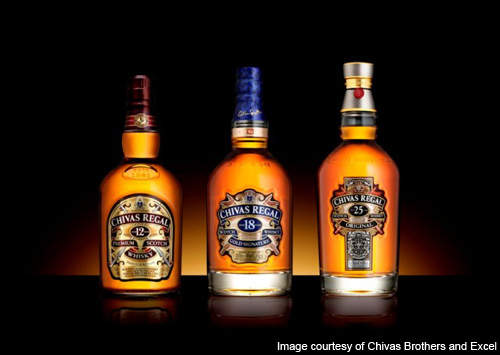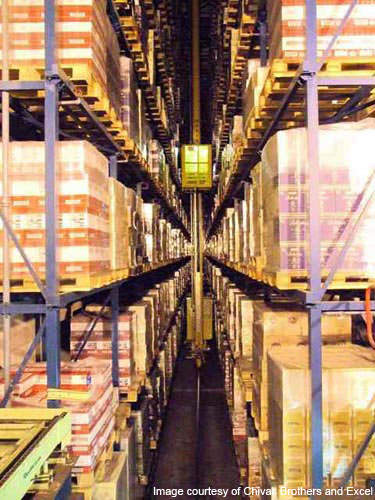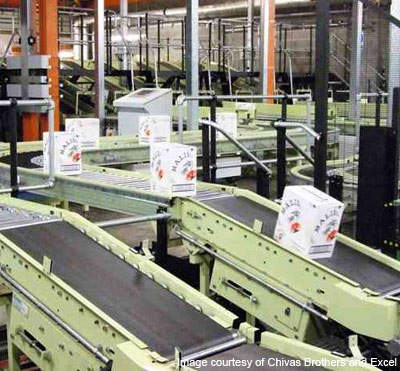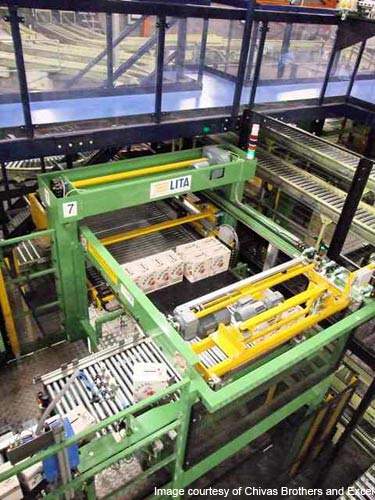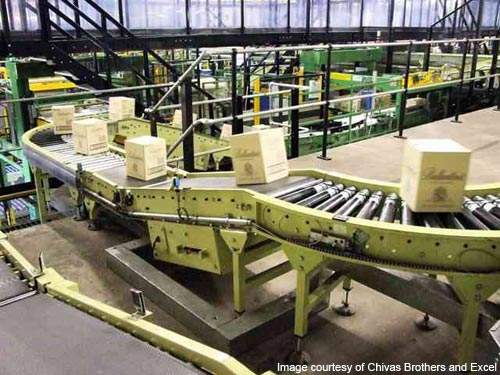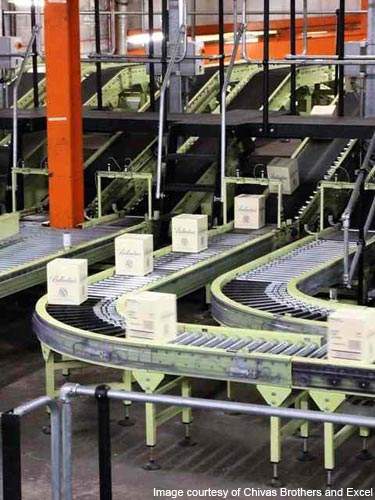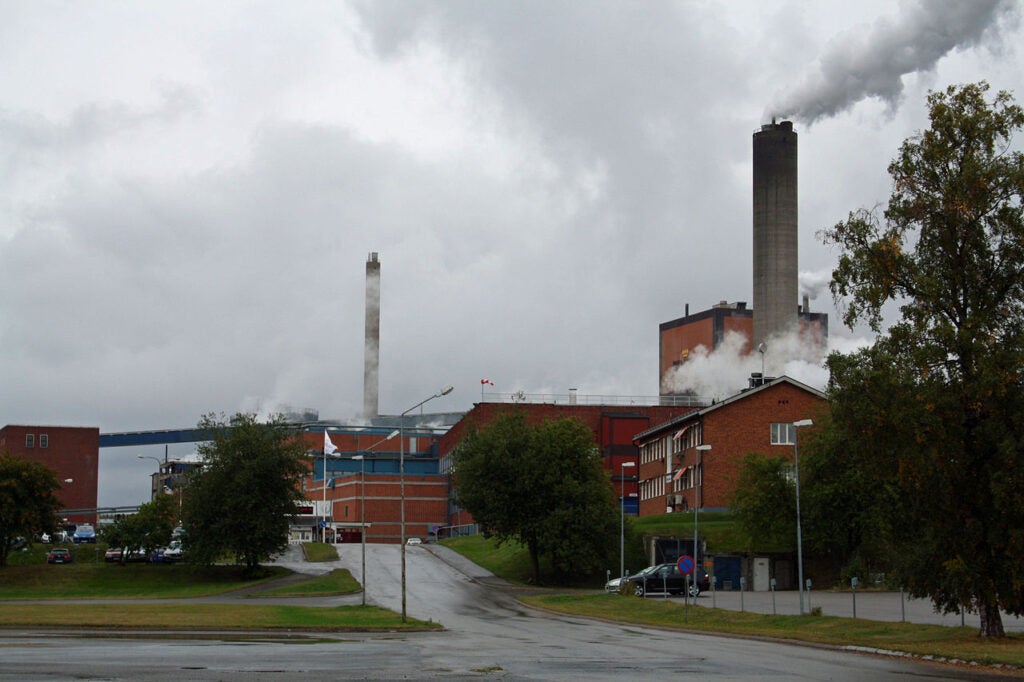Chivas Brothers is a major manufacturer of premium branded gin and whisky based in Scotland, UK. Its signature brand is Chivas Regal, a range of three blended whiskies matured for 12, 18 and 25 years. The company is now owned by French spirits group Pernod Ricard, having been acquired in 2000 from the Canadian Seagrams Group.
The Chivas distillery is the Strathisla Distillery at Keith, at Moray in Speyside, but the company also has a major bottling facility at Kilmalid, Dumbarton. The Kilmalid facility, which plays a major part in the bottling and distribution of Chivas Regal, Ballantine’s whisky, Beefeater gin and Malibu, produces more than 20 million cases a year.
In October 2009 the company was reaching the end of a major refurbishment of the packaging operation at its Kilmalid bottling plant.
Upgrade
In 2005 Chivas Brothers decided the packaging infrastructure at the Kilmalid bottling plant needed an upgrade. The project, which began in 2006, was undertaken in four phases to minimise disruption at the facility during peak demand. The upgraded systems included the conveying, palletising, shrink-wrapping, storage and dispatch systems (the project has involved the replacement of equipment with faster, more efficient systems and increased automation).
Control systems for four phases of the project were supplied by Autotech Controls Ltd and the main contractor and project manager for the handling systems was Excel Automation. The overall project has increased output from Kilmalid by 50%.
Phase one
The first phase involved an overhaul and upgrade of the eight automatic narrow-aisle stacker cranes and the installation of a new control system, which includes a new intelligent Rockwell AC drive system with full closed-loop control via laser positioning devices on the horizontal and vertical movements. The advantage of the new technology is that it eliminates the need for on-board PLC controllers and provides improved functionality.
This phase also involved the installation of two-man (man-rider) manual drive cabs equipped with human / machine interfaces (HMIs) to make stock checking within the high-bay stores safer and easier. The first phase, completed in mid-2006, increased the throughput of the warehouse by 20% to 144 pallets in / out per hour.
Phases two, three and four
The second phase of the project involved the replacement of the seven shrink-wrapping machines with two high-speed stretch wrappers and the replacement of the in-feed pallet conveyor systems for the automatic warehouses. Phase three saw the replacement of seven palletisers with eight new ones, and the replacement of the conveying systems from the eight production lines of the Clyde bottling hall to the new palletisers.
The new phase three conveying systems were designed to transport different sized cartons that contain a variety of bottle sizes from the bottling plant into the palletising plant, where they are sorted into pallet profiles.
Prior to the cases entering the eight new palletisers the top of the cartons are sprayed with a cold glue (a lock ‘n’ pop cold glue system prevents damage from strapping) to hold each layer of cartons together to form a stable block, which is then delivered to the wrapping area.
The phase three order was placed in June 2007 and work began the week before Christmas 2007 (phase three was fully operational by April 2008). The last phase of the project, which was completed in May 2009, involved the replacement of the 12 dispatch lanes that fed the old clamp-type pallet exchangers with an improved pallet exchange system that included new laser-guided automated guided vehicles (AGVs).
A crane refurbishment project was also awarded to Excel in early 2009 and has involved the refurbishment of two cranes in the bulk glass area, which holds empty glass bottles prior to filling. The two 28-year-old Demag manual cranes both received a comprehensive mechanical upgrade and electrical control systems to convert them to fully automatic operation. An Invar warehouse inventory system was installed to sequence and control the complicated bottle-picking process.
Phase three
The Clyde bottling hall has eight production lines, each of which is assigned to one of the eight new palletisers. Each palletiser can handle two lines simultaneously, allowing routine maintenance to be carried out without difficulty. Dedicated case conveyor lines transport cases between the bottling plant and the palletisers at a speed of 60 cases per minute.
The conveyor system required 1,000m of Excelveyor 500 series belt-driven carton conveyor to be installed. Every 600mm section of the roller conveyor installed up to the palletising area is equipped with an Itoh Denki soft-start system consisting of a ten-speed adjustable motor, a variable frequency controller and a photocell. The motor drives the rollers, the photocell detects the position of the boxes and the controller decides when the line must start and stop.
This line-mode accumulation system prevents the cases colliding, bottles breaking and liquid spilling, and manages the flow of cartons on the conveyors. The filled cases are then fed into an accumulation tunnel to build up a pallet load. Because different brands and bottle sizes require different case sizes, more than 50 different pallet filling combinations, or “patterns”, are available within the system to achieve maximum efficiency from a standard pallet size.
Pallet loads of cases are then transported to the palletising and automatic dispatch facility (PAD) building and from there incline conveyors carry them to the high-level (7.8m) in-feed for the palletisers using Chivas 1,200mm x 1,000mm pallets (these are used until wrapped cases are transferred to customer pallets). Loaded pallets are moved to the stretch wrapping machines using one of two Excel pallet conveyors. The maximum throughput is 62 cases per minute.
The new pallet conveyors incorporate two Mancon 1710 stretch wrappers and two Excel pallet profile and weight checkers. The stretch wrappers are from MJ Maillis and use a new infrared cutting and welding system designed to eliminate film tails, which can cause false readings by control systems.
Technology
Chivas required lock ‘n’ pop cold glue system for the new operation because strapping and hot melt glue methods had caused pack damage. Before loads enter the palletiser, the lock ‘n’ pop system now sprays the tops of all cases with a light coating of glue to hold layers together as a ‘block’.
The cold glue system has greatly improved the stability of the pallet stacks, which can be eight layers high. The equipment uses two 1040l totes of pre-mixed, water soluble adhesive to feed the eight palletisers. These are sited centrally on the ground level on a standard four-way entry pallet for ease of forklift handling (refilling).
The automatic lock ‘n’ pop applicators supplied are equipped with triple spray guns, which allow the palletiser software to determine which box size receives which application. Stephen Trainor, project manager for Chivas Brothers at Kilmalid, said: “The system is handling luxury goods and the loads are quite fragile, so the combination of lock ‘n’ pop and soft-start conveyors provides very effective protection for the valuable cargo.
“By eliminating lateral movement between the layers of boxes, lock ‘n’ pop also enables us to reduce the amount of stretch wrap used on each pallet and allows easy de-palletising without damaging carton surfaces or graphics.“

